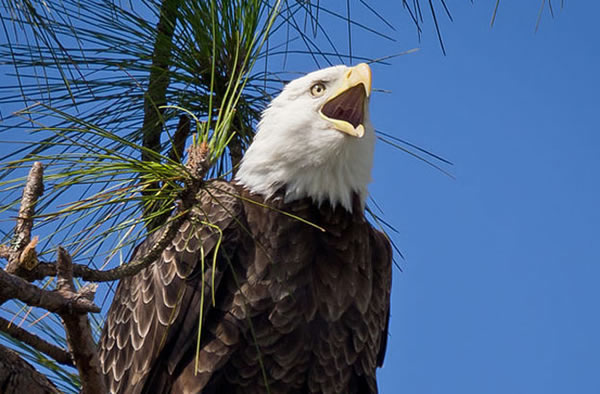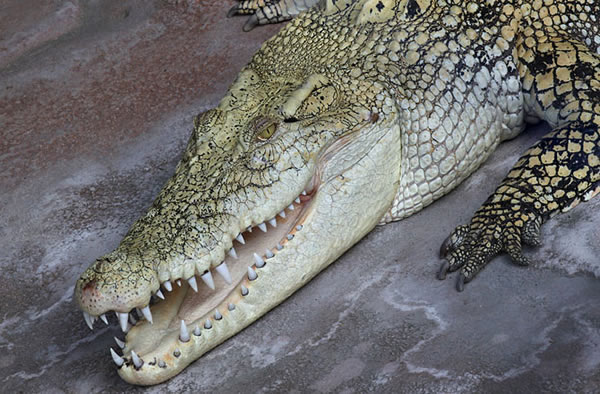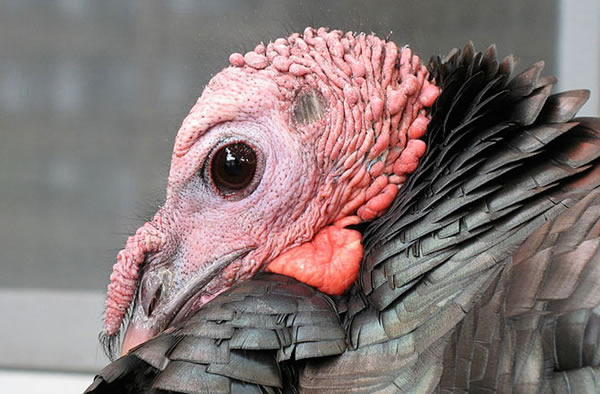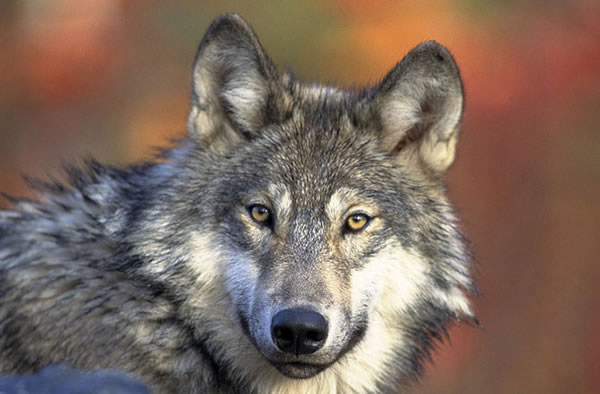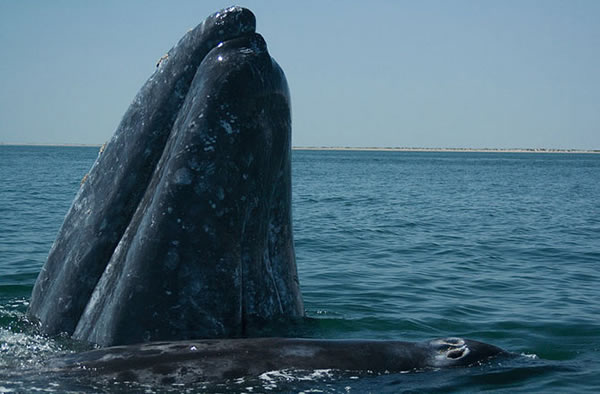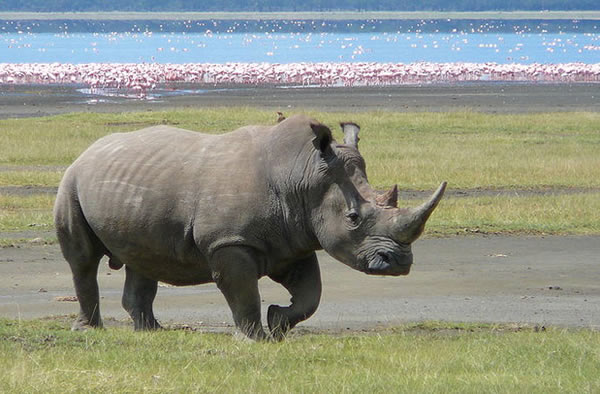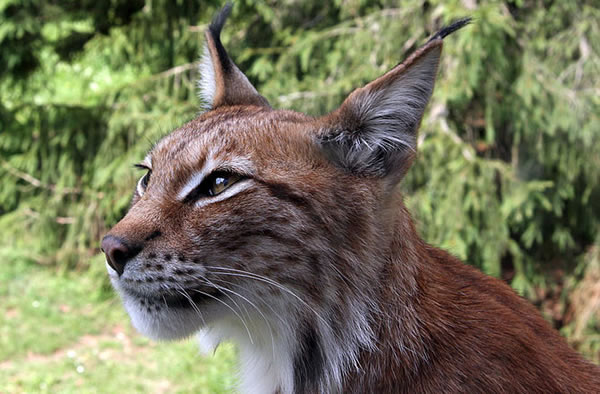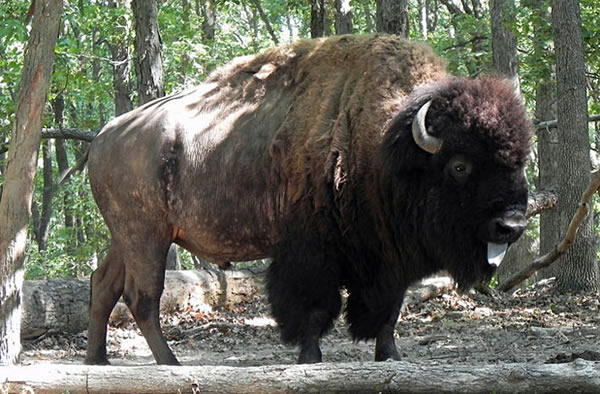Animals Back From the Brink
Bald eagle
Bald eagles
America's national symbol flew off the Endangered Species List in 2007 and won't be landing on it again anytime soon. Hunting and pesticide contamination once decimated bald eagle populations, and by 1950 only 416 mating pairs soared over the lower 48 United States. A major threat to the eagles was the pesticide DDT, which Rachael Carson made infamous in the book Silent Spring. The pesticide built up in the food chain and caused the eagles' eggs to have fatally thin shells.
Aggressive protection programs and the banning of the pesticide DDT saved America's avian symbol. Now, the eagles are so numerous that the National Fish and Wildlife Service doesn't bother keeping yearly tallies. The last count of mating pairs in the lower 48 was 9,789 in 2006. Bald eagle watching is now a tourist attraction in many states. The eagles are out of immediate danger, but still fiercely protected by national laws which make it illegal even to collect feathers from naturally deceased birds without permission.
However, the protected status of bald eagles and their kin, the golden eagle, have caused problems for some Native American groups that need feathers from the birds for their religious ceremonies. U.S. government officials allot the feathers to religious leaders, but only after years of waiting on a long list.
Saltwater crocodile
Saltwater crocodile
The world's largest crocodile went the way of the dinosaurs in much of its range. The saltwater crocodile (Crocodylus porosus) once ambushed prey along coastal waterways from Vietnam to southern India and northern Australia. A global fashion for crocodile leather killed off the animals in most of continental Asia. Many were also killed out of fear or as food.
However, the crocodiles down under are staging a comeback. “Salties,” as Aussies call the crocs, rebounded in much of northern Australia, after their populations in the 1970s dropped to approximately five percent of their former numbers. Legal protections and bans on crocodile products have allowed the giant reptiles to bounce back. They are now considered a species of Least Concern by the International Union for Conservation of Nature.
One of the largest crocodiles ever captured recently died in captivity. The 20+ foot long reptile, known as Lolong, died in captivity in the Philippines on Feb. 10, 2013.
Wild Turkeys
Wild Turkeys
The wild turkey, Ben Franklin's choice for America's national bird, suffered the same fate as the bald eagle. Wild turkeys (Meleagris gallopavo) were abundant from the Rocky Mountains to the Atlantic when European colonists first arrived. Then, hungry colonists and habitat loss nearly gobbled up the turkey. By the mid-1800's wild turkeys had been wiped out in much of the Midwest and Eastern U.S. The birds survived in remote parts of Missouri and Arkansas.
Attempts to restore populations using domesticated turkey's failed, possibly because the original domesticated turkeys hailed from Mexico and couldn't effectively go feral in the frigid north. Only birds transplanted from their holdouts in Missouri and Arkansas managed to survive reintroduction programs. The reintroduction of these birds was a huge success and turkeys have returned to much of their former range, and even areas where they never lived, like Hawaii and southern California.
Gray wolves
Gray wolves
The gray wolf is still the second most widespread land predator, although humans (the top widespread predator) have reduced their historic range by approximately one-third. In areas where the wolf was once whipped the canny canids are making a comeback.
European wolves benefited from the continent's gradual move away from agricultural economies. As less people farmed and ranched, the wolves faced less persecution as threats to livestock. In Italy, the gray wolf population continues to increase into the hundreds and has now spread into France's Mercantour National Park and the western Alps. Italian wolves are doing so well they even have time to enjoy the finer things in life. Recent studies have found that some wolves in Tuscany are gourmands, who prefer wild boar to the deer other European wolves eat.
American wolves are retaking territory as well. The wolves lost a tremendous geographic range during the past few centuries. They once covered nearly the entire North American continent as far south as central Mexico, but extermination campaigns pushed them north of the Canadian border, with only a few remnants left in the lower 48 states by the 1950s.
U.S. gray wolves have returned to areas of the northern Rocky Mountains, where they were removed from the endangered species list last year. The wolves have also spread south in Wisconsin from a stronghold in Minnesota. Last year Wisconsin had its first organized and legal wolf hunt in recent history. However, the hunt drew criticism from groups, including the Center for Biological Diversity, that considered the population (~800) to be too small for a hunt. Wolf hunts in the Rocky Mountain region also have been contentious, especially the practice of hunting wolves from helicopters.
Gray whales
Gray whales
Whalers preferred other species to the gray whale (Eschrichtius robustus), but that didn't stop whalers from nearly wiping them out. The oil of the gray whale was considered inferior to right and bowhead whales. Grays were often hunted only after more valuable species had been wiped out.
The need for whale oil went out with bowler hats and mustache wax. Since that time, gray whales have recovered in the eastern Pacific and now number more than 26,000 along the west coast of North America. The whales have become the center of a lucrative trade once again, but this time, it's the living whales that have value. Thousands pay to see gray whales as they migrate from Mexico to the Arctic.
Gray whales in other regions haven't been so lucky. The western Pacific population is critically endangered. An Atlantic population had disappeared from European waters by the time of the fall of the Roman Empire and the population in the western Atlantic died out in the early 18th century.
The Atlantic hasn't remained barren of gray whales, though. A gray whale was spotted in the Mediterranean in 2010. Some biologists speculate the grays may be recolonizing the region by passing through the waters north of Canada, now that climate change has reduced the ice cover and opened a passage.
Southern White Rhino
Southern White Rhino
The southern white rhinoceros (Ceratotherium simum simum) was considered extinct in the late 19th century. Pith-helmeted big game hunters had nearly done in the fourth largest land animal.
Then, when hope for the rhino seemed lost, a remnant population of less than 100 animals was found in Natal, South Africa in 1895. After more than a century of protection, the southern white rhino now numbers approximately 18,000.
Threats still loom for the rhinos. A booming trade in black market wildlife products currently fuels a resurgence in rhino poaching. Wildlife managers in South Africa have begun treating rhinos with a medicine originally meant to kill parasites. A side effect of the medicine makes the rhinos' horns poisonous to humans, which discourages people from ingesting powdered horn as an aphrodisiac.
Lynx
Lynx
Like the gray wolf, the Eurasian lynx (Lynx lynx) was never in danger of going completely extinct. Instead the cat had been wiped out in much of its former habitat in western Europe. Also like the wolf, the lynx survived only in remote regions, with large populations only in the northern forests.
In December, Eurasian lynx made their first appearance in Hungary after more than a century. A young lynx was photographed in the forested mountains of Aggtelek national park, 250 kilometers (155 miles) northeast of Budapest, reported the AFP. A ban on hunting lynx in neighboring Slovakia may have allowed the cats to come back.
Bison
Bison
In the 18th century it got harder to find a home where the buffalo roam. The tremendous herds of American bison were annihilated with amazing speed, until only a tiny fraction of the population remained. Yet, some hope that the Wild West may once again reverberate with the thunder of millions of bison hooves.
The eastern subspecies of bison, known as the wood bison (Bison bison athabascae) is the largest land animal in the western hemisphere. Unfortunately a botched reintroduction program hybridized many of the remaining 1,500 wood bison with plains bison contaminated with bovine tuberculosis and brucellosis. By 1940, it was believed that the wood bison had been completely replaced by the hybrids. Then a population of approximately 200 was discovered near the Nyarling River in Canada in 1959. These pure wood bison survivors were the core of a resurgent population that now numbers approximately 11,000 in conservation herds.
Plains bison have improved their numbers as well. The IUCN counts approximately 20,500 plains bison in conservation herds. Another 500,000 bison live as livestock in captive commercial populations. However, some would like to see those bison out of their fences. An IUCN report suggested that restoring the massive herds of bison to the American landscape would be the best long term survival plan for the bison. The report noted that serious legal and infrastructural challenges stand in the way of returning the bison to their former range.
Mar 8, 2013 09:00 AM ET by Tim Wall
